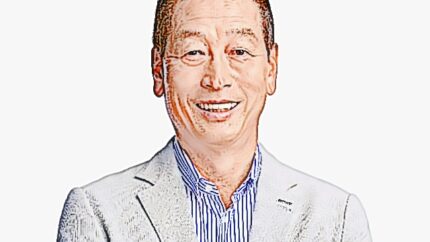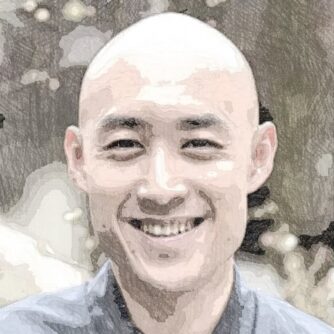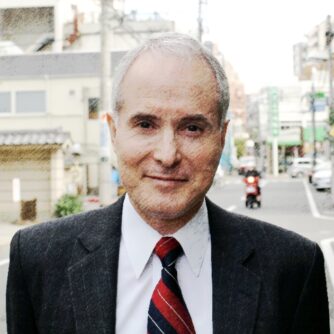In this Part 2 of my conversation with “Tani,” we went back to the topic of people. As a long-term investor, I believe the most valuable intangible value of the company for their ongoing sustainable growth is the people. All companies say that people are their most valuable asset, but people don’t show up as an “asset” on the balance sheet. It shows up as a “cost” on the P/L. And, many Japanese corporations don’t really do good job in showing the value of their people, since many of them are still in the “Showa” mode of sectionalism silos, seniority system. So, let’s see how Tani’s people focus strategy was able to change that culture.
https://corp.shiseido.com/en/company/board/
Tani declares that his mission is to unleash the people. In order to do that, he needed to change the culture, which in turn meant to change people’s mindset and organizational behavior.
For example, Shiseido’s traditional organizational structure was divided into two: headquarters and local sales companies. Headquarters were responsible for new product development, R&D, marketing and advertisement strategy, whereas the local sales companies met the needs of customers from Hokkaido to Okinawa.
Even though their functions were different, Tani found out that all of their employees were recruited by one company, Shiseido. Yet, headquarters and local sales companies were mentally and emotionally divided as well. It was the role of headquarters to tell people in the field at the sales company what to do, and they just followed the orders. A one-way sort of business process created the culture. Diversity was non-present, and the management at that time was mono-culture of all senior men. Many organizational silos existed.
Even though headquarters believed that they created a great new product, they were concerned that the sale groups were not strong enough to distribute. On the other hand, sales company complained that they needed better products to be developed.
Therefore, Tani decided, “Let’s stop this.” Shiseido needs to act like “ichigan” (all for one, one for all) like everybody has been telling him. So, he merged the two organizations into one. No more sales company. No more headquarters. Just one company, from the beginning of value chain to the end. What Tani did not know that this was the biggest organizational change for Shiseido in 90 years. Needless to say, a big decision.
However, this created change. The marketing people and key salespeople were in the same office, sitting next to each other. When a big drug store customer wanted to do a campaign, the salespeople immediately contacted the marketing and branding people. Customers started to comment that Shiseido was becoming much faster to their requests.
The same kind of situation occurred in Europe, when Tani visited the offices in 2015. In Madrid, there were two organizations, Shiseido Spain and BPI Spain, a fragrance company. Therefore, he asked them to gather at one place for a meeting. They replied, “We never got together before.” Tani replied, “Okay, so this will be the first time, let’s do it.” The same thing happened in France and Italy as well.
At the management team meeting in Paris, Tani said, “Okay I need a decision by you by 5 pm, since my flight leaves at 7pm. We are going to integrated into one company for each country.” Obviously, this created a buzz, as the team all started debating. At 5 pm, Tani said “Okay, my plane is leaving. What is your decision.” They said, “Yes, we can do that.” And, they did.
Tani believes that Japanese company with a global strategy, needs a clear vision. One can be a global winner with a Japanese heritage. Being global doesn’t mean going away from what the company has built in Japan. The core identity should not be lost, but rather enriched. Only then can the Japanese company grow globally.
When Tani started to recruit European and American professionals, he found that even in the Western world, there was a segment of people that love what Shiseido had built in Japan. When he hired senior management in Spain, Italy, and Russia from other large cosmetic global companies, they all said, “We like Shiseido’s pursuit for high quality products,” which was by far the industry standard for high quality, but “we also feel Shiseido has a very good sense of being part of the family.”
Tani therefore was able to confirm that there was nothing wrong with keeping Japanese value, such as “Sanpo-Yoshi” or stakeholder management of the seller, buyer and society. Being a global company in this industry doesn’t mean just copying what American and French cosmetics companies have done, but rather to build on the heritage and be proud of it.
Tani is a believer in the concept of “Think Global Act Local.” With a global strategy framework, regional management should be put into place, and you must trust them, you must empower them, since after all, the execution is done by them. This has not been the traditional way of Japanese company trying to do global business. For, Shiseido, the first stage of globalization was the headquarters in Tokyo, sending their people abroad. Tani orchestrated the second stage, of empowering the regional organizations, where there are now 6 regional headquarters that is managed functionally with a matrix organizational structure.
A big part of Tani’s job is communicating how the future will unfold for Shiseido. The global cosmetic industry is in fact a close-knit of community, where professionals in New York and Paris all know each other. Tani was out in the industry papers, and many people in the industry got interested in Shiseido. Everybody knew it was a good company. The “sleeping beauty” was waking up, and many people in the industry wanted to be part of that change. Shiseido was able to attract capable non-Japanese talents to evolve into a hybrid global organization.
Even though Tani values face-to-face meetings, in the present world of corona virus, management of a global company must resort to on-line meetings. However, Tani says that he is well-known for making frequent phone calls, even though there are no specific issues, just to check-in to see what’s going on. Even though on-line meetings are the norm, analogue form of communication is still important.
The role of a CEO is leadership in order to create value. But sometimes, CEO must cut losses and make the decision to walk away. “Business is not always perfect,” Tani admits. “The resiliency of a brand is different, and the corona crisis has made these differences really visible.”
But a strong business has better resilience. Tani believes that Shiseido needs to “build back better, to be a stronger company after corona.” After going through the exercise of strategic management, and at the end of day, once the decision is made, whether it is a divestment or cost-cut, which are not a pleasant decision, “the people need to have ownership of that.” This is Tani’s style.
Last year when the corona crisis first hit, Tani sent out memo to all the regional management team. “Let’s not assume that it is going to come back. Let’s take this situation as an opportunity to transform our business to be stronger.” He wanted the team to come up with a vision how Shiseido can be stronger in 2023, assuming that effects of the corona pandemic have ended by then.
“I am a champion of giving homework,” says Tani. He gave 1 month to the regional teams to do their internal exercise. What will be strategic issues. What are the options to solve the issues.
After one month, each region made their presentation and Tani was “really impressed.” Downsizing the organization is tough work. “However, everybody took a position from the group point of view. Not just their own interests.” Tani was very pleased to see vision for growth for the group for the future. They were tough decisions, but “we decided together.”
Tani believes that once the team feels that they are trusted, they feel ownership. As CEO, Tani affirms his commitment to his management team, and in order to support them in execution, he established a “Global Transformation Committee” that meets every two weeks. Every region is sharing the progress, and “everybody knows what is going on in other part of the group.”
Divesting business and concentrating resources will increases efficiency, but it is a tough decision for management, since this may leave the company vulnerable, particularly if the area of choice does not do well. Tani believes that there isn’t a “Yes-No” kind of answer.
In the stock market, there is a tendency of a conglomerate discount, and certainly he learned when he was at Coca-Cola the benefits of being very single minded in a “great business.” On the other hand, there is the portfolio approach of brands and regional businesses that complements each other when there are issues.
Shiseido is not a conglomerate, since they are just in beauty products. But they are in the prestige premium business model of using beauty counseling. They were also in the personal care business, where self-selection products are distributed through supermarkets and drug store that require advertisement for that segment. These business models are completely different.
Shiseido has decided to focus on the premium counseling beauty business. Tani believes that this business may evolve to new businesses with the utilization of DX (digital transformation). For instance, a new engagement model with consumers that services health conditions, since skincare is linked to diet and sleep quality.
So, Shiseido’s business model is not a “conglomerate” but rather a very strong diversifiable model, striving to develop new adjacent businesses, based on their core strengths. “Shiseido has “high quality skin care and R&D technology expertise. We must build on it,” declares Tani.
Shiseido’s “Global Innovation Center” S-Park is a facility that looks like a gateway to this business focus. Located near Yokohama Station, it is an impressive site that opened a couple of year ago. When Tani arrived at Shiseido and started his conversations internally within Shiseido as well as externally with the industry, he was reaffirmed that their core strength was R&D innovation and quality. Yet, through his organizational review, he was concerned that Shiseido was not investing enough in this area.
When he arrived the R&D budget was around 1.8% of total sales, when it used to be around 3%, the industry standard for many of Shiseido’s competitors. Tani’s initial reaction was to take that back up to 3%. Moreover, it was not just about the annual budget for R&D, investments to upgrade facilities was also important.
When Tani first started his conversations with the R&D people, their research center was about 30 minutes from Shin-Yokohama Station. It was a good facility but with a limited budget, the equipment was not state-of-the-art. And the location was rather isolated.
As mentioned earlier, Tani felt that his mission was unleashing the people. Therefore, management discussions began, to confirm the need to invest in R&D, and a 3.5% of total sales budget was targeted to build a new facility much closer to consumer activity.
At the new facility, S-Park, scientists and researchers commuting to work can pass by department stores at Yokohama Station, to see and feel the new trendy fashion, the color, the everyday experience of looking at their consumers.
A custom laboratory was set up near the entrance to the facilities to provide a tangible contact point with customers. It is a small laboratory where the consumers can drop by, have skin diagnosis with experts, and can have their own custom-made product in 2 hours. Shiseido had to obtain permission from authorities to produce consumer products there.
There was a special bonus for Tani. His wife approved. “Wow, this is really different. This really works for me.” Currently the laboratory is temporarily closed because of the corona situation, but be sure to stop by S-Park if you are in the vicinity of Yokohama Station.
We turned our discussions towards Tani’s personal global perspective of the state of the world, the opportunities and risk for our planet. Tani believes that “sustainability” doesn’t just mean environmental issues, but much bigger. Tani asks out loud, “How can we make planet sustainable for the future. How can we make our company sustainable for the future.”
“There are over 7 billion people in the world, and we are reaching crunch time, whether we can be sustainable or fall into serious disruption.” In order to achieve a sustainable environment, society and business, Tani believes that everyone needs to work together, be part of the planet, be part of the community, and “our business is beauty and services, and we should be part of that.”
Shiseido is examining their logistics and supply chain, working towards a commitment to achieve to carbon neutral by 2026. They became part of the LOOP Project, working with their retailers of refilling their products in recyclable packages. They are also working on biodegradable packages materials as well.
At same time, because of their business nature, diversity and inclusion, which is not just gender, is also very important. Particularly for Japanese companies, gender inclusion is must point for a start. Currently, at Shiseido in Japan, 35% of managers are women and this is expected to rise to 50% in the next several years. 46% of board members are women, so almost half. And 66% of mangers outside of Japan are women.
Tani believes this diversity and inclusion is important not just for Shiseido, but also for the overall community, and is inviting other Japanese CEOs to work together on this issue. Japanese labor customs, recruitment fresh out of university, seniority system, and lifetime employment are the reasons for the current situation. This corporate system made japan very successful in 70s and 80s, but is “not going to work anymore, and is an obstacle to growth,” declares Tani.
Showa Era (1926~1989), especially the latter half, was the past success model of “Made In Japan.” Heisei Era (1989~2019) was the transition model of “Made By Japan.” For the current Reiwa Era (2019~), we need a new model of “Made With Japan.” Tani agrees with this observation and says that new model should be designed for the future.
The future of Japanese businesses with a decline of population in the home country, should be keeping base in Japan but going out of bound to do business overseas. Providing goods and services and therefore making money outside of Japan and bringing it back is the mission of Japanese company, says Tani.
In order to realize this new model, “we need to understand regional difference in culture and language, and we need different people familiar with these differences.” This means diversity. There are currently 68 different nationalities working for Shiseido in Tokyo. When Tani arrived at Shiseido, they employed less than 100 foreign nationals, mainly Chinese. Currently there are about 500.
In order to make diversity happen, Shiseido introduced English as the internal common language in 2018. Tani received an array of reactions from “going global” to “not possible.” But these days, Tani is quite impressed with the progress. Currently, there are 3 non-Japanese on the management team at headquarters.
Stayed tuned for final Part 3 of my conversation with Tani, where we will be discussing about the younger generations that will be creating our future.



